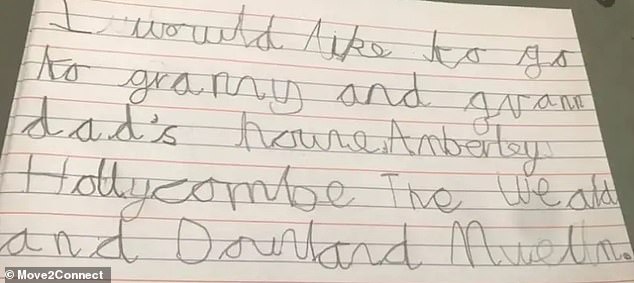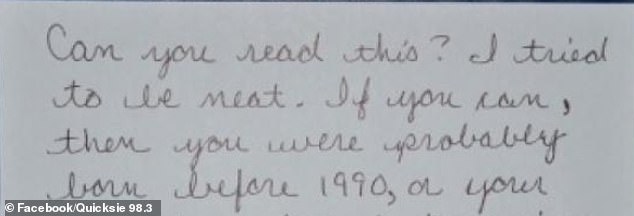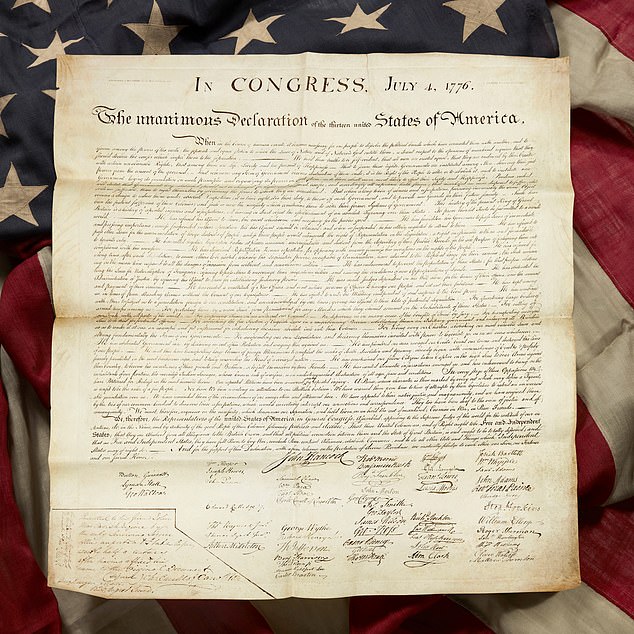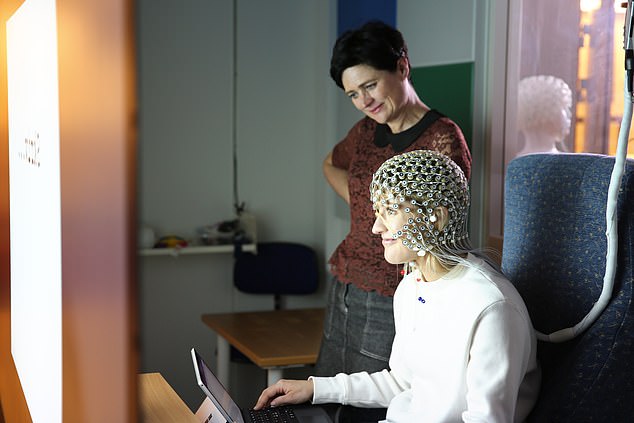Several US states are trying to prevent handwriting from going extinct as classrooms increasingly swap pen and paper for tablets and computers.
The US government removed the skill from the core curriculum in 2010 due to claims it was time consuming and would not be useful in the age of technology which meant schools could instead focus on typing classes.
Handwriting is considered a fine motor skill that stimulates and challenges the brain, but with schools turning to technology instead, some teachers are complaining students can barely hold a pencil but can swipe and double-click on their devices.
Students with learning disabilities like dysgraphia – when children can read but have trouble writing letters – can also be affected because methods of overcoming the disability requires them to practice writing by hand.
Previous studies have revealed that IQ scores have dropped for the first time in a century and indicated that technology could be to blame.
Teachers, parents and experts who DailyMail.com spoke to said they were seeing kids and young adults who don’t know how to sign their name or read cursive.

Handwriting isn’t being used in schools like it once was, and experts say they’ve noticed students are having trouble holding a pencil but are able to double-click or swipe on a digital device

Handwriting isn’t being used in schools like it once was, and experts say they’ve noticed students are having trouble holding a pencil but are able to double-click or swipe on a digital device Picture: A sixth-grader’s cursive after it was removed from the common core standard in 2010

Experts have urged schools to re-introduce cursive into the curriculum, citing the need to understand historical documents. Pictured: Cursive written before it was removed from the common core standard in 2010
New legislative bills have been passed in states like California and New York requiring students aged six to 12 years old to learn cursive writing, but others are still advancing in state legislature while some are still hesitant to revert back including Colorado, New Mexico and Nevada.
‘I wish [students] would learn how to write in cursive,’ Tracy Bendish, an ABA autism therapist for Jefferson Public Schools told DailyMail.com.
‘But it is like the telephone on the wall,’ she said. ‘Less and less used and then not there anymore.’
There is a big educational disparity between schools that readily have access to gadgets versus those that don’t, causing what’s called the digital divide.
Students who have better access to technology will have better educational success than those who don’t, which is particularly concerning as more teachers turn to technology in their courses.
‘The digital divide has affected individual students in the same school as well as groups of students across districts, lowering the academic outcomes of low-income, underserved students and districts,’ according to American University.
Last year, researchers at the University of Oregon and Northwestern reported that IQ scores had dropped because technology shortens attention spans and decreases the need to think deeply.
Experts have been urging governments and school administrators to bring handwriting back to schools, citing sixth graders who have trouble holding a pencil but can use digital devices with ease.
Dr. Lori Koerner, the assistant superintendent for the Riverhead Central School District in New York, told DailyMail.com that it is essential for elementary and middle schoolers to be taught cursive.
‘Though technology has its benefits, children need to be able to read cursive in the event a document is presented to them along their journey.
‘They most certainly, at the very least, need to know how to sign their name,’ Koerner said.
‘I have encountered too many secondary students and employment candidates who cannot sign documents relative to their onboarding process.’
Teachers and coworkers continue to struggle with ineligible handwriting, and a 2021 survey conducted by OnePoll on behalf of Bic USA Inc. found that 45 percent of Americans struggle to read their own handwriting while a shocking 70 percent reported that they have trouble reading notes or reports from their coworkers.
Some people have expressed similar views, saying that signing important documents will become a stressful practice without the ability to write cursive.
‘My 20 year-old-granddaughter struggles to sign a check,’ said Kimberly Jacovino of Monroe, Connecticut.
‘It is very important and should be brought back to all schools,’ she added.
In the wake of turning to keyboarding instead of writing by hand, educators found students’ IQ levels are shrinking and placed the blame on technology in the classroom, Psychology Today reported.
Hetty Roessingh, a professor emerita of education at the University of Calgary echoed this sentiment, saying that five-year-olds are not meeting academic benchmarks because of the accessibility of digital devices.
Roessingh has long advocated for schools to push handwriting and cursive on children because it is an important tool to engage the hand-brain complex and circuitry that induces memory and retrieving information that typing simply doesn’t do.
A new study published in February by researchers at the Norwegian University of Science and Technology (NTNU) found that handwriting is linked to increased cognitive brain function, motor skills and memory.
‘It is important to realize that the brain follows the principle of ‘use it or lose it,’ said Audrey van der Meer, the study’s lead author and neuropsychology professor at the NTNU.
‘When writing by hand, most of the brain is active,’ she continued.
‘This requires the brain to communicate between its active parts which, in turn, puts the brain in a state that helps both children and adults learn more and remember better,’ van der Meer said.

New legislative bills are now requiring students aged six to 12 years old to learn cursive writing, and experts argue that it’s necessary to read historical documents like The Declaration of Independence

Other documents, like the diary of Anne Frank (pictured), could become lost if schools don’t keep cursive as part of the curriculum.
Schools stopped teaching cursive in 2010 when most US states adopted what’s called Common Core State Standards, which set benchmarks for reading and math but didn’t include cursive as part of the recommended curriculum.
At the time, critics said teaching efforts would be better spent on developing new skills like coding and keyboarding while others called the writing style ‘old fashioned.’
When dropping cursive from common core, lawmakers argued that cursive was time-consuming and wouldn’t be as useful as other skills like typing, that students would need at they moved on to junior and high school,’ a then-spokesperson for Georgia Department of Education told ABC News at the time.
Cursive also wasn’t on the tests that ranked schools under the No Child Left Behind Law which was put in place by the Bush Administration in 2002 and ended in 2015.
Schools would typically gear their learning curriculum around what was required under the No Child Left Behind Act (NCLB) which set benchmarks for academic performance that all schools had to meet.
If they continuously failed to meet the NCLB standards, the state had the right to change the school’s leadership team or even close the school.
Forty-one states adopted the common core curriculum and while individually they were able to choose to teach cursive, California and Massachusetts were among the few states to opt in.
Roughly six years later, 14 states reintroduced the writing style into all classes, and by 2019, that number grew to 20 states.
Democratic assemblywoman Sharon Quirk-Silva introduced a bill in California last year, citing the need for students to not only be able to write in cursive but to read it as well.
The California bill will go into effect for the upcoming 2024-2025 school year but similar bills are still pending in states like Kentucky where, if it’s passed, would be implemented in the 2025-2026 academic year.
The push is also in response to the ever-increasing artificial intelligence technology, which Quirk-Silva believed will cause teachers to return to handwritten essay exams necessitating students’ ability to write in cursive because it is faster than print.

A new study revealed that handwriting contributes to sensory and memory and triggers a cognitive response. Pictured: Audrey van der Meer, the study’s lead author and neuropsychology professor at the NTNU with Katja testing her brain’s cognitive response to typing versus handwriting
If handwriting becomes extinct, it would be a major loss to understanding history or connecting with our past, Roessingh said.
‘It is about the embodied cognition and the circuitry behind personal messages that are beneficial both for the person who wrote it and the person who read it,’ she said.
Handwriting, particularly cursive, presents the idea of what’s called embodied cognition, meaning it acts as a switch to lock in your memory.
This makes it increasingly important for kids to write by hand and learn cursive because they are ‘essentially tactile and sensory beings who take in the world through engagement,’ Roessingh explained.
More than that, a piece of history could be lost to younger generations who aren’t taught to read and write cursive, leaving them unable to read major historical documents like the diary of Anne Franke, the US Constitution and the Bill of Rights.
Chelsea Hayes, a Maryland mom, said regardless of what schools decide, she plans on making sure her three-year-old daughter knows how to write in cursive when she gets older.
‘I do think it’s important. Not just for historical purposes, but also just as a skill. I think it’s almost like learning another language,’ Hayes said.
‘You don’t teach kids art or music because of history, though I guess there’s a historical component you can put in there.
‘It’s just another skill I think she should have. If she never uses it, oh well. If she does, great.’








